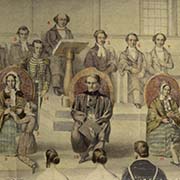CANADA HISTORY
Lord Elgin

Lord Elgin's tenure as Governor General of Canada marked a crucial turning point in the development of responsible government, a foundational principle that would shape Canadian democracy. As the son-in-law of Lord Durham, whose influential report had recommended self-governing institutions for the colonies, Elgin came to Canada with a strong commitment to reform. His appointment in 1848, following the election of reformers in the British Parliament, signaled a clear directive to move Canada toward the full establishment of responsible government. This meant that the executive power would be accountable to the elected representatives of the people, rather than merely to the colonial governor or British authorities.
Elgin began this process by calling upon two leading reformers, Robert Baldwin and Louis-Hippolyte Lafontaine, to form an Executive Cabinet. Baldwin and Lafontaine were staunch advocates of responsible government and used their positions to select members of the Legislative Assembly to fill key executive roles. This marked a fundamental shift in Canadian governance, as the executive branch was now dependent on the confidence of the elected assembly, rather than being appointed solely by the colonial administration. It was a reflection of the concurrent evolution of the British parliamentary system, where Queen Victoria was also learning to work with new political leaders who, despite differences, represented the will of the people through their party's majority in Parliament.
The transition, however, was not without turmoil. In 1849, the passage of the Rebellion Losses Bill became a flashpoint. This legislation was designed to compensate those in Lower Canada who had suffered property damage during the rebellions of 1837-1838. While the bill was highly controversial, especially among conservative and Tory factions who viewed it as rewarding disloyalty, Lord Elgin chose to sign it. Although he did not personally agree with all aspects of the bill, his signature was a powerful demonstration of his commitment to responsible government. Elgin understood that, under this new system, the governor's role was not to impose his personal will, but to act in accordance with the decisions made by the elected representatives in the Assembly.
The reaction from entrenched business interests, conservative politicians, and social elites was immediate and violent. Elgin’s carriage was stoned by radical Tories, and in Lower Canada, anger over the bill culminated in the burning of the Parliament Buildings in Montreal. These acts of resistance were rooted in a deep fear of change and a desire to maintain the colonial status quo, where power was concentrated in the hands of a few, rather than shared democratically. Even more extreme was the response from some Tory factions who, in their outrage over the changes, launched a movement advocating for Canadian independence and annexation to the United States. This annexationist campaign, supported by conservative business interests, sought to align Canada more closely with American political and economic systems, rather than embracing the reforms being implemented under British governance.
However, the annexation movement quickly collapsed. It lacked broad support from the Executive Council, the Legislative Assembly, and the general population, who were beginning to see the benefits of responsible government. By standing firm in the face of these challenges, Lord Elgin ensured the success of this new political framework. His actions validated the authority of the Assembly and set a precedent that the governor’s role was no longer to dictate policy, but to act as a constitutional figurehead who respected the will of the elected representatives. In doing so, he secured the future of responsible government in Canada.
Lord Elgin's tenure was pivotal not only because it introduced responsible government but because it demonstrated the resilience of these principles in the face of fierce opposition. The successful implementation of responsible government under Elgin’s leadership laid the groundwork for Canada’s later constitutional development, and it remains a cornerstone of the country’s democratic system. His tenure helped transition Canada from a colony governed by distant British authorities to a self-governing political entity, setting the stage for the Confederation of 1867. In this way, Lord Elgin's contributions were essential to the formation of modern Canada, cementing the country's path toward full sovereignty and democratic governance.
Cite Article : www.canadahistory.com/sections/documents




